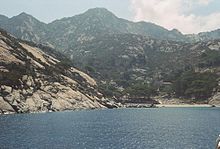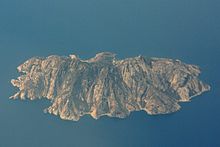Montecristo
Montecristo is an Italian island halfway between Corsica and the Italian mainland, south of Elba and west of Giglio. Now uninhabited by humans except for a gamekeeper's station, the island is part of the Tuscan Archipelago and rests on a granite base. Administratively, it is part of the municipality of Portoferraio.
The entire island surface of 1039 ha was designated as a nature reserve by the Italian government in 1970 and can only be entered with special permission. Only a limited number of visitors are allowed. Until 2018, the maximum limit was 1000 visitors per year; since 2019, 2000 visitors per year are allowed. From 2019, access to the island is subject to payment and is only possible between 2 March and 15 April and between 15 May and 31 October. No access is allowed between 16 April and 14 May for bird conservation reasons. Registration for the visit is possible online from mid-February (as of 2019) and includes, after payment in advance, transfers from Piombino Marittima and Porto Azzurro on Elba, and in some cases from Porto Santo Stefano and the island of Giglio. The number of visitors allowed is limited to 75 people per calendar day. In addition to the visit to the island by appointment including boat transfer, it is possible to go to Montecristo by private boats. In this case, the visit is carried out by the staff of the Carabinieri Forestry. The prices depend on the hull length of the boat and the number of people on board. A vessel can be authorized per day with a maximum of 15 people on board. As there is no infrastructure on the island, it is not possible to provide food, drink or medical supplies. Swimming on the island of Montecristo is prohibited all year round.
Feral goats have been living on the island for centuries. Their isolation from their conspecifics has made them interesting for genetic research and they are also known as Montecristo goats in research.
The highest point is the Monte della Fortezza (645 m s.l.m. ).
The only buildings on Montecristo are: the ruins of a 13th century monastery - this was founded in the 7th century and destroyed by pirates led by Dragut in 1553 - the mid-19th century villa of British art collector George Watson Taylor and the gamekeepers' station.

Cala Maestra

Aerial view of the island
History
The beginnings of Montecristo's settlement probably date back to the Neolithic period (5th to 6th millennium BC). In 1994, a large number of ceramic sherds, some richly decorated, and a flint artefact were excavated in the bay of Cala Maestra; in 2000, a millstone and other flints were discovered at the same site at a depth of around one metre. The first finds, however, can be traced back to Gaetano Chierici (1819-1886), an Italian palaeontologist, ethnographer and priest, who was able to attest to three flints as early as 1875.
Before the aforementioned foundation of the monastery in the 7th century, a community of monks who felt themselves to belong to the Roman Catholic creed had settled on Montecristo since at least the end of the 6th century. To these, Pope Gregory the Great sent an abbot named Orosius in 591 AD to take charge of the monastic community.
Literary setting
The island is famous as one of the settings in Alexandre Dumas' novel The Count of Monte Cristo, but the real island and that of the novel have little in common. German nature filmmaker and director Florian Guthknecht has made several documentaries for ARTE and ARD about the EU's Life conservation projects on the island, most recently "Montecristo: A Treasure from Plunder", which looks at the consequences of the world-famous novel for Montecristo's sensitive ecosystem.
Search within the encyclopedia